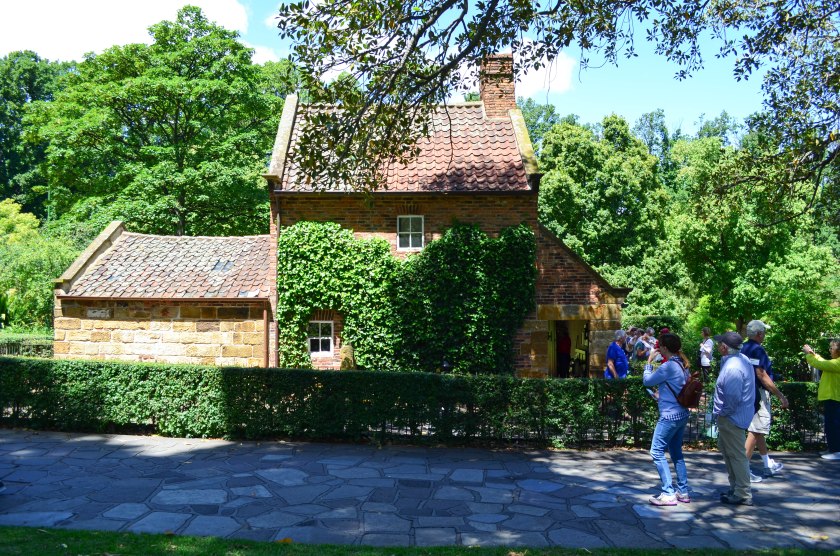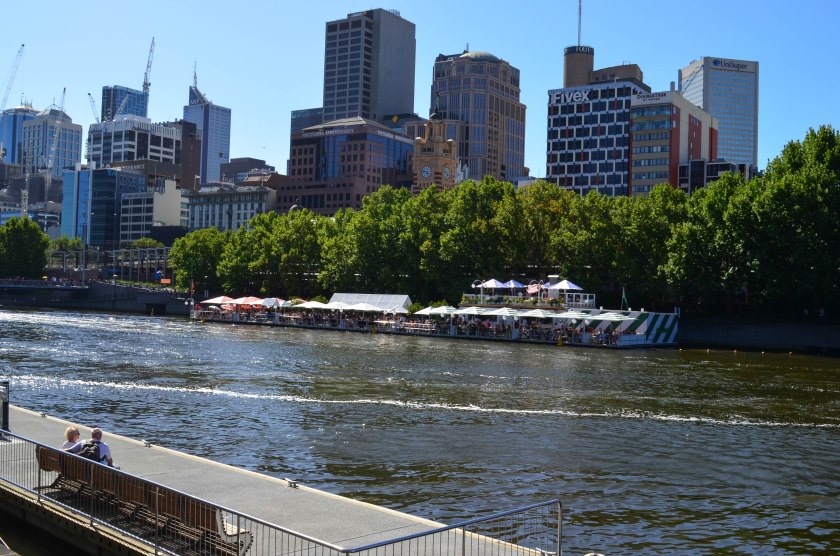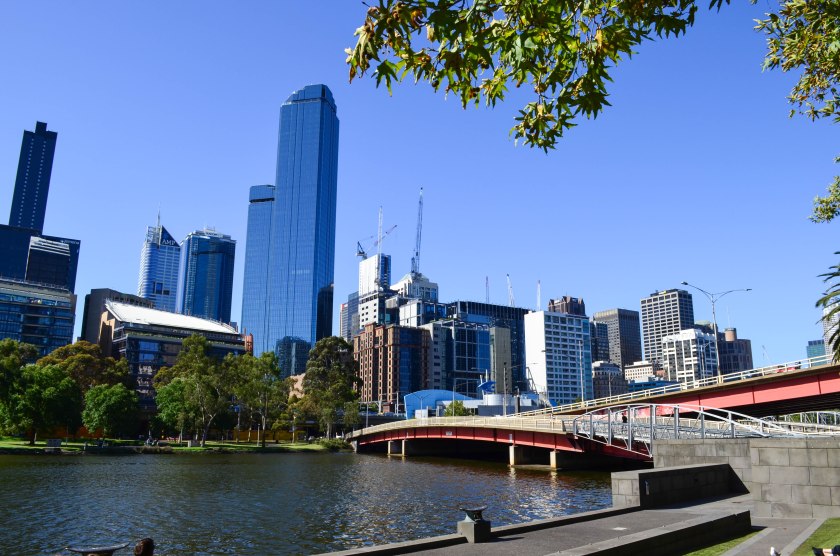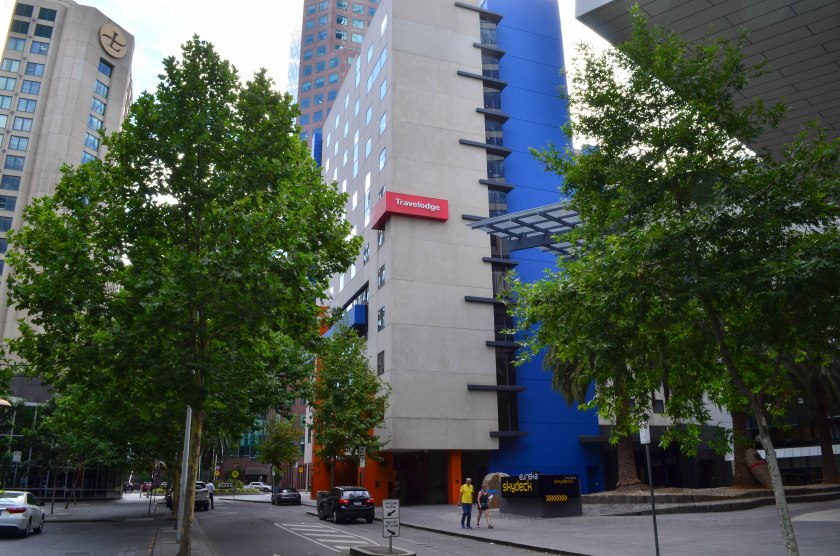The alarm goes off at 5.30 and I have had my first full nights sleep, unlike Vickie who has been up in the night feeling ill. We get all packed up and ready to leave and by 6.45 are down for breakfast where we find the rest of our group tucking into the full works fry up. We have some fruit and toast, partly because it’s too early to eat too much, and partly because we thought that 16 days of full breakfasts would leave us with no clothes that would fit for the journey home! Our guide tells us that our flight has been amalgamated with one leaving half an hour earlier, so at 7.30 we are on the bus and off to the airport, which being Sydney is only 10 minutes away. The bus pulled up at a door marked Group Check-in and we all waited whilst our guide went inside and the driver got the cases out onto the pavement. We had to push our luggage all of 15 metres to where a man tagged them and put them on the belt and our guide handed us each a ticket – the whole thing probably only took a minute or two. We decided this group check in lark was just the ticket! We still had to go through security on our own though and then we had to hang around in departures but at least it was only about half an hour. Sydney has Australia’s biggest population at about 5.4 million, but is being caught by Melbourne with just over 5 million. They have long been the biggest and richest cities in Australia, but neither is the Capital, that honour falls to Canberra, the 7th biggest. Australia only became a country on 1 January 1901, before that what are now states were separate colonies of the British Empire that were all individually governed. When Federation, as it is called was agreed, Melbourne and Sydney where the richest and most populous cities and an argument raged for years about which should be the Capital. Although the Federal Government operated from Melbourne it was never officially the capital. In 1908 the argument was finally settled by choosing a tiny village in the middle of nowhere. The village and surrounding area became the Australian Capital Territory so that it would not be under the influence of any of the other states. The city was designed from scratch as the Capital City but it was not until 1927 that Parliament House was completed and the whole Federal Government moved to Canberra. We flew over Canberra on the way to Melbourne, but we failed to spot it. The flight was shorter than we expected as we were only in the air for about an hour and a quarter. The rivalry between the two biggest cities continues as we had already learnt from our tour guide who was born in Melbourne! We came in to land over green rolling hills, farmland and woods which could easily have been England. I could see no sign of a large city so surmised that it was either on the other side of the aircraft or a long way from the airport. It took almost as much time as the flight for all our cases to arrive on the belt and for us to assemble as group outside. This was partly because we were effectively two flights on one aircraft carrying over 300 people. Although our tour guide comes from Melbourne she lives in Paris and had flown out with us from London, however her father works at the airport and he was there to meet us and welcome us to Melbourne. The drive into Melbourne city centre took us about 40 minutes as the airport is 24 km, or 15 miles away, which is why I had not spotted it as we came in to land. We had a running commentary on the way in from the coach driver, our tour guide and her Dad! We stop on La Trobe Street outside Melbourne Central, which is a combination of multi-level shopping mall and the main railway station. It is quite disorientating as we don’t know where we are in relation to the city centre, nor which direction we have travelled in from the airport. The idea is that we stop here for lunch and we find a dark and dingy food court in the basement where we get coffee and a hot baguette to share. It’s really a quite depressing place and the only redeeming feature is that inside the building is Coop’s Shot Tower. A shot tower was used for the production of lead shot, primarily used in shot gun cartridges. Little drops of molten lead fall from the top of the tower into a water bath at the bottom, which produces perfectly spherical balls of lead. This 50 m high tower was built for the Coop family in 1889 and produced 6 tonnes of shot every week right up until 1961. The tower was preserved when the shopping mall was built in 1991 and is covered with an 84m high steel and glass conical roof.

After lunch it was back on the bus and more driving through the city and having various landmarks pointed out whilst also getting the low down on some of the history from our three commentators who were clearly enjoying sparring with their knowledge. After a while we came to the coast at Port Melbourne Yacht Club. It looks like the coast and open sea but I’m not sure if technically it is? It is actually a huge roughly circular bay that is about 60 km across and with a shoreline of 264 km although the entrance from the open ocean is only 2.5 km across. It is called Port Phillip Bay and we drove south east along the foreshore for about 5 km, past St Kilda beach and marina. Unfortunately we didn’t stop, so no photo opportunities. We turned back inland and drove past Albert Park and Lake and despite being told Melbourne is famous for it’s black swans we only saw one swimming in the far distance. For some people Albert Park is more famous as the venue of the Australian Formula 1 Grand Prix. The circuit uses public roads and encircles the lake. A short way from here stopped at The Shrine of Remembrance, a huge war memorial in the King’s Domain park near the city centre.

We had about 30 minutes to have a look around and also take in the views of the city centre. From here we hopped back on the bus and drove along the intriguingly named Batman Avenue. It turns out that John Batman was one of the founding fathers of Melbourne back in the early 19th century. This passes by some notable sporting venues including the Olympic Park and the Melbourne Arena where a major tennis tournament was about to start. Next stop was Fitzroy Gardens, a large Victorian park with many mature trees

and a curious tourist attraction called Cook’s Cottage. It was built in 1755 in Yorkshire by Captain Cook’s father, but Cook never lived there, he had already been at sea for ten years when it was built.

In 1934 a chap called Sir Russell Grimwade bought the house, had it dismantled, packed brick by brick into barrels and shipped to Melbourne for the centenary celebrations. Once re-constructed in Fitzroy Park it became an immediate tourist attraction and still is today. Entry to the house was included in our tour so we queued up to get inside, six at a time to have a look around the pokey two up two down. Vickie was feeling really quite ill by now and just wanted to get to the hotel, but we still had another half hour of driving around, mainly it seems so that we could drive past the MCG or Melbourne Cricket Ground on Brunton Avenue. We finally arrived at our hotel, The Travelodge Hotel Melbourne Southbank, right next door to the Eureka Skydeck. It turned out that the hotel is only a 10 minute walk from Cook’s Cottage. As Sod’s Law would have it the hotel were not ready for us and our tour guide had to have a huge row with them as they wanted us to sign in individually and leave credit card deposits and so on. By the time the manager was found and the matter resolved we had to wait for half an hour in reception. Everywhere else we went our keys were waiting and our guide just handed them over as we got off the bus! We dumped the bags in the room and went to the nearest bar on the Southbank Promenade for a quick beer.
Vickie was feeling really quite ill by now and just wanted to get to the hotel, but we still had another half hour of driving around, mainly it seems so that we could drive past the MCG or Melbourne Cricket Ground on Brunton Avenue. We finally arrived at our hotel, The Travelodge Hotel Melbourne Southbank, right next door to the Eureka Skydeck. It turned out that the hotel is only a 10 minute walk from Cook’s Cottage. As Sod’s Law would have it the hotel were not ready for us and our tour guide had to have a huge row with them as they wanted us to sign in individually and leave credit card deposits and so on. By the time the manager was found and the matter resolved we had to wait for half an hour in reception. Everywhere else we went our keys were waiting and our guide just handed them over as we got off the bus! We dumped the bags in the room and went to the nearest bar on the Southbank Promenade for a quick beer. Vickie returned to the room and I went in search of ‘Lemsip’ and somewhere close by for dinner later in the evening. I walked along the Southbank Promenade, an area of many restaurants and backed by skyscrapers of apartments and office space. Until the 1990’s this was an industrial area but due to regeneration it now feels like a wealthy up-market place. Views across the Yarra River are of the city centre and Flinders St Station.
Vickie returned to the room and I went in search of ‘Lemsip’ and somewhere close by for dinner later in the evening. I walked along the Southbank Promenade, an area of many restaurants and backed by skyscrapers of apartments and office space. Until the 1990’s this was an industrial area but due to regeneration it now feels like a wealthy up-market place. Views across the Yarra River are of the city centre and Flinders St Station.

The river is 150 miles long and is near it’s end here so is quite wide. Yarra valley will be familiar to wine enthusiasts as it is well known for producing many great Chardonnay and Pinot Noir wines that are available in the UK. Past Queen’s Bridge I continued along the river front on what is now Yarra Promenade and checked out all the bars and restaurants until I had a mental list of a few places to visit over the next three nights.

At Clarendon Street the restaurants and bars run out so I turned around and headed back to the hotel. As Vickie was still quite under the weather that evening she just fancied a simple burger and chips for dinner, so I had found a couple of bars with smoking terraces and a restaurant within about 200 m of the hotel. We went to Left Bank for a pre-dinner glass of wine and a smoke before going to Hopscotch for dinner. It’s a kind of bar diner where you order food at the bar. We found a table outside and ordered a Cheese Burger and a BBQ Burger, with fries and a side of onion rings. Being Australia the portions were so huge that we were unable to finish, but it certainly did the trick in terms of meeting Vickie’s need for comfort food. We eventually decided that we couldn’t think of the last time we had been out for burger and chips but thought it may have been over 15 years ago!! After our meal we went next door to the Soho Bar and had coffee and a glass of Yarra Chardonnay on their smoking Terrace, before returning to the hotel.


What a building with that underskirt!!
LikeLiked by 1 person